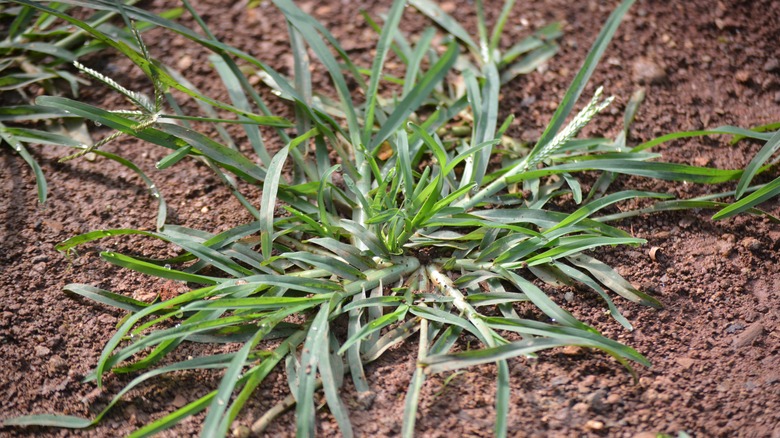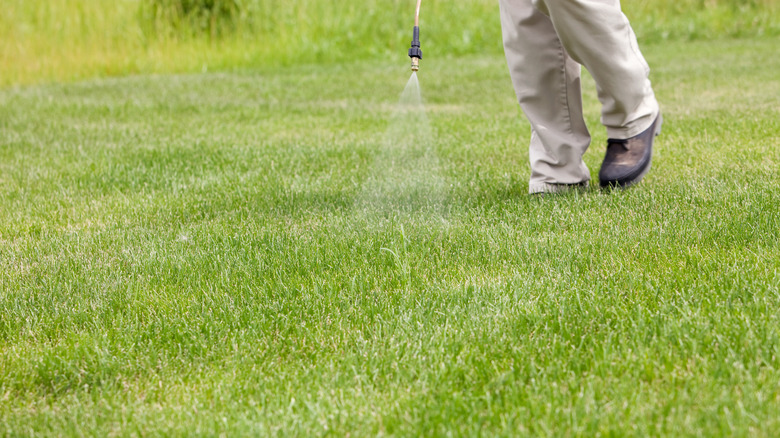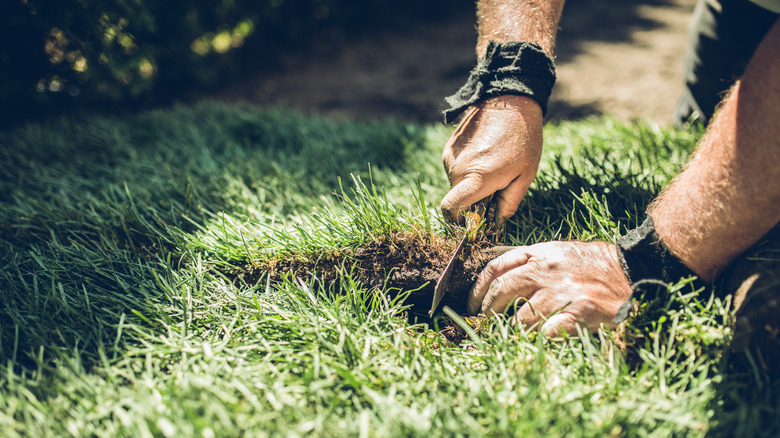Why You May Want To Think Twice Before Using Herbicides To Get Rid Of Goosegrass
We may receive a commission on purchases made from links.
Goosegrass is a common grass weed that is often mistaken for crabgrass. These pesky annuals are most often found in the northeastern states, and while their life cycle only lasts one summer, they leave behind a mountain of seeds when they die. This creates a recurring cycle each season. Because of this, you might be tempted to take care of the problem using herbicides, which are chemical sprays that kill off unwanted vegetation. However, that might not work to remove your goosegrass problem.
This stubborn weed has been known to become resistant to herbicides, staying put and thriving in your lawn even after the poisonous spray has been applied. Secondly, since goosegrass often pops up in late spring and early summer, early applications of herbicide in early spring miss the weed, and it sprouts up anyway. Here is a deeper dive into why herbicides might not be the most effective tool to battle your goosegrass problem.
Why you shouldn't use herbicides to attack goosegrass
You can often spot goosegrass on high-traffic spots on your lawn, where plenty of feet have stomped down the turf, creating packed-down soil and bald patches of grass. Because it tends to sprout up where there is little grass, it makes its appearance even more noticeable (and unsightly.) Because of this, you might be itching to blast it away with herbicide. However, goosegrass has a history of developing immunity to such sprays after years of overuse. For example, a 2018 study in Brazil found that goosegrass has become resistant to herbicides after being exposed to them for 10 years straight. But this isn't just happening in South America — it's a worldwide issue. Different varieties of goosegrass have become resistant to different varieties of herbicides, making it difficult to eradicate. For example, three types of goosegrass in North Carolina have become resistant to Prowl, Sonalan, and Treflan herbicides. Because of this, you might have to try several different brands to get rid of your weed problem or resort to different methods altogether.
Secondly, herbicide use might not be the best option because the timing of applying it might be tricky. Most turf professionals recommend using pre-emergence herbicides over postemergence ones since they're more economical. The former is sprayed into the soil and kills the weeds before they sprout. However, if you apply it too late, the weed will have already begun to grow, rendering the application useless. In addition to that, irrigation and rainfall eventually dilute the spray's power, weakening its strength over time. Similarly, the longer the herbicide sits in the soil, the more microbes begin to break it down, making it less effective.
How to treat goosegrass
If you want to try using herbicides anyway to control goosegrass, there are two things to keep in mind. First, if you prefer to use pre-emergent herbicides, you will need to apply them twice during spring in order to catch the weeds' late germination cycle. Apply it once in the early spring, and once again in late spring, right before the goosegrass is about to sprout. If using postemergence herbicides, you need to pick a herbicide that has been proven not to have a history of resistance. University extensions recommend Pylex herbicides, but they're most effective when you combine the product with methylated seed oil — such as Southern Ag Methylated Seed Oil – or crop oil concentrate — such as Hi Yield Crop Oil Concentrate. They also recommend using Tenacity herbicides, but only if the goosegrass is new and young. It's most effective when mixed with a nonionic surfactant, which helps lower the surface tension between the spray and leaf. This allows the liquid to spread over the leaves better, which in turn gives the herbicide a better chance to penetrate the weed and kill it with its active ingredients. An example of such a surfactant is Alligare 90.
If you want to manage goosegrass without herbicides, university extensions recommend smothering it out with healthy turf. Plant those bald spots with new, dense grass. You especially want to focus on planting cool-season grass since it will grow when the goosegrass dies, providing major competition to the weed seeds. Secondly, research has shown that not cutting your grass too short also helps reduce the weed's survival rate. That's because taller grass creates more shade, making it difficult for the weed seeds to sprout.


